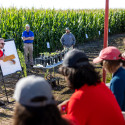Undergraduate Symposium set for April 12
When visitors walk through the labyrinth of poster displays on Tuesday, April 12, in the Memorial Union Great Hall during the 2005 Undergraduate Symposium, they may be getting the first glimpse of the next generation of academic scholars.
The symposium has steadily grown in participation and now consistently attracts more than 200 presenters. This year, 244 students will take part, with 118 poster displays, 68 oral presentations, seven panel presentations and 17 art displays. The event will begin with a welcome to all participants at 9:45 a.m. in the Great Hall.
Psychology professor Charles Snowden, a frequent contributor of undergraduates to the event, says the symposium can be a career-defining experience. “This type of work promotes confidence,” he says. “The process in general, and the symposium in particular, can boost the intellectual and academic self-confidence of students.”
English professor Heather Dubrow agrees. “One of the main goals of faculty is to empower students, to make them aware that their work is of interest to the outside world, not just in an academic context,” Dubrow says. “With this event, it may be the first time their work is presented to other people, and it often builds greater self-respect and self-confidence.”
Following are some projects of interest this year:
-
Mentoring Connections: After a semester volunteering at Oakhill Correctional Institution in Oregon, Andrea Williams encountered a subset of the population seemingly lost to researchers and social agencies: the children of incarcerated parents.
Williams is working this spring with human development professor Julie Poehlmann in evaluating a new pilot program called Mentoring Connections. The federal program, steered by Madison-area Urban Ministries, helps children, ages 4-15, with an incarcerated parent strengthen their ability to form strong relationships by providing mentors to help them through the tumultuous time.
Williams says she intends to pursue a master’s in social work and is strongly motivated to work with these children, who are at a high risk of following in their parents’ footsteps. “The cycle of incarceration that has been shown to happen in these families is heartbreaking,” says Williams. “I guess that I just want to throw a wrench in the cog, so to speak.”
-
Does Red Bull really give you wings? Zoology student Allison Bichler posed the question and, with the help of Biocore faculty associate Michelle Harris, found the answer that will surely disappoint waves of college students. Bichler looked at the effects of caffeine and taurine, the two main active ingredients of Red Bull and other energy drinks, and found no correlation on improving short-term memory. Energy drinks have become popular among students seeking a study-hour jolt.
-
Wolves in our midst: Student Lisa Michl is analyzing 20 years of data from the Wisconsin Department of Natural Resources’ Wolf Damage Program, which compensates people who lose livestock or pets due to wolves. Michl is totaling the money paid through the program and marking locations of claims to draw conclusions about how well wolves and humans are coexisting in Wisconsin.
-
Arts in rural America: Sociology student Anne Guettler is working with sociology professor Lyn Macgregor to study the impact of artistic production on the economic and cultural vitality of small towns. Guettler’s study of small towns in four states found that community investment in the arts does spur credible economic opportunities.
-
Wearable Earth: A number of inspired efforts are coming from students in the environment, textiles and design department. Student Sonja Nesse is assembling a collection of handmade clothing, called De La Terra, “inspired by small moments of exquisite beauty within nature’s rough extremes.” And in a project dubbed “Terrible Beauty,” student Raven Berry is developing pastoral scenic designs on textiles inspired by “the beauty of insects.”
Tags: learning




